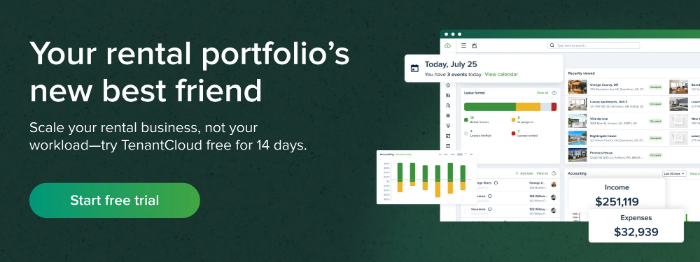As a landlord, you’ve probably had that one phone call: the one where a tenant reports a fire, flood, or break-in... and then sheepishly admits they don’t have renters insurance. What starts as a tough call can quickly spiral into a full-blown crisis for everyone involved.
While your landlord insurance may protect the building, it won’t cover the tenant’s personal property. That gap leaves them vulnerable, and you potentially caught in the emotional—and sometimes legal—aftermath.
That’s where renters insurance steps in. More than just a smart safety net, it’s a practical way to protect both tenants and landlords, reduce risk, and foster more secure landlord-tenant relationships.
We’ll walk you through everything you need to know about renters insurance—what it is, what renters insurance covers, why it matters, and how to talk to your tenants about it confidently. Whether you’ve got one unit or a hundred, renters insurance is a small step with a big payoff. Let’s break it down.
What Is Renter’s Insurance and Why Does It Matter?
So, what is renters insurance? Simply put, renters insurance is a policy that helps protect a tenant’s belongings and provides liability coverage while they’re living in a rented apartment.
Unlike homeowners insurance, which covers the building itself, renters insurance focuses on what’s inside—your tenant’s personal property. Many landlords assume their own insurance is enough, but it only covers the structure, not the tenant’s items or liability. Then confusion happens.
In reality, renters insurance offers essential coverage for things like fire, theft, and even certain accidents. It’s a small investment with major protection for both the tenant and the landlord.
What Does a Renters Insurance Policy Typically Cover?
A standard renters insurance policy—also called an HO-4 policy—offers more protection than many renters realize. It usually includes three distinct types of coverage: personal property coverage for your tenant’s belongings (like furniture, electronics, and clothes), liability coverage in case someone gets hurt in their apartment, and additional living expenses if the unit becomes uninhabitable due to a covered loss.
Common covered losses include fire, smoke damage, water leaks, vandalism, and theft. This policy covers much more than people think and can save tenants thousands after an unexpected event. For landlords, requiring renters insurance is a simple way to protect both your property and your peace of mind.
Understanding Personal Property Coverage in Depth
Personal property coverage is the heart of a renters insurance policy—it protects what your tenants own inside the rental. This includes furniture, clothing, kitchen appliances, electronics, and even items like jewelry. If any of these are stolen, damaged, or destroyed due to a covered loss, the tenant can file a claim.
Coverage is typically based on either actual cash value (what the item is worth today) or replacement cost coverage (what it costs to buy new). Both options have value, but replacement cost is more comprehensive.
Even in short-term rentals, protecting personal belongings gives tenants peace of mind—and keeps landlords out of stressful conversations about who pays for what.
How Renters Insurance Liability Coverage Works
Liability coverage protects your tenants if someone is injured in their unit or if they accidentally damage someone else’s property. Whether it’s a friend slipping on a wet floor or a guest tripping over a rug, legal fees and medical bills can accumulate fast.
This is where personal liability and bodily injury protection come into play. A good renters insurance policy can cover medical costs, court judgments, and even legal defense. For landlords, this helps reduce exposure to potential lawsuits.
Encouraging tenants to carry liability coverage is a smart move—it’s not just about protecting them, it’s about safeguarding your apartment and business too.
What Renters Insurance Doesn’t Cover
While renters insurance protects you from a wide range of risks, they don’t cover everything. Standard policies focus on named perils like fire or theft. But certain types of damage—like floods, earthquakes, or sewer backups—are usually excluded unless additional coverage is purchased.
High-value items such as art, collectibles, or expensive jewelry may also require special riders. It’s important to know where the limits are and when a separate insurance policy might be needed.
Landlords should encourage tenants to read their policies closely and consider additional coverage if needed. After all, understanding what isn’t covered can be just as important as knowing what is.
Renters Insurance Costs and Payment Options
The good news? Renters insurance is surprisingly affordable. Most policies range from $12 to $30 per month, depending on where the tenant lives, how much coverage they choose, and what deductible they’re comfortable with.
Tenants can often save more by bundling policies or installing safety features like deadbolts or smoke detectors. Leading insurance companies like GEICO, TD Insurance, and even integrated options through TenantCloud make purchasing simple and budget-friendly.
The right plan helps tenants protect what matters without breaking the bank—and gives landlords confidence that both the building and its residents are better prepared for the unexpected.
Related: Fire Safety Tips: Ensuring a Secure Living Environment
Actual Cash Value vs. Replacement Cost Coverage
Not all coverage is created equal. When a tenant files a claim, their payout depends on whether their policy uses actual cash value or replacement cost coverage. Actual cash value coverage reimburses based on the item’s depreciated value, so a 5-year-old TV might only fetch half its original price.
On the other hand, replacement cost coverage pays what it would cost to replace that item brand new. It costs a bit more but offers far better protection, especially for first-time renters or students with newer items.
Choosing the right type of coverage is a critical part of any renters policy—and worth discussing with an insurance agent.
How to Buy a Renters Insurance Policy in 5 Steps
Purchasing a renters insurance policy doesn’t have to be complicated.
- Start by taking inventory of your personal property—a calculator can help estimate the value.
- Then, compare insurance companies to find the best fit for your needs.
- Next, choose your coverage limits based on how much it would cost to replace your belongings.
- Pick a deductible that balances affordability with out-of-pocket risk.
- Finally, apply online, over the phone, or through an insurance company.
Pro tip: Bundling a renters policy with auto insurance often leads to discounts. Customizing your insurance policy ensures you're only paying for what you need—and nothing you don’t.
Why Landlords Require Renters Insurance
Requiring renters insurance isn’t just about policy—it’s about protection. While a landlord’s responsibility includes the structure, it doesn’t cover tenants’ personal items or liability risks. A renters policy offers liability protection for things like property damage or injury claims, taking pressure off the landlord. It also promotes responsibility: tenants who value coverage tend to respect their space.

Some landlords even allow pets when renters have appropriate coverage for pet-related issues. Whether it’s safeguarding against lawsuits or filtering for more reliable tenants, requiring renters insurance protects your property and your peace of mind. It’s one simple step toward smarter property management.
Related: Ultimate Guide to Property Management Inspections: What to Look For & Why It Matters
Real-Life Examples: How Renters Insurance Saved the Day
Renters insurance becomes real when things go wrong. One tenant was displaced after a fire—thankfully, their additional living expenses coverage paid for hotel bills and meals. In another case, a stolen laptop and TV were fully replaced thanks to replacement cost coverage.
And when a guest slipped and fell during a dinner party, the tenant’s policy covered medical costs, avoiding a stressful legal situation. These are everyday examples, not rare occurrences. According to the Insurance Information Institute, only 57% of renters have coverage, even as claims rise.
In unexpected circumstances, renters insurance is a financial lifesaver that helps renters hang onto the things that matter most.
How Much Renters Insurance Do You Really Need?
Knowing how much coverage to buy starts with knowing what you own. A personal property calculator can help tenants estimate the value of their belongings so they don’t underinsure them. It’s easy to forget how quickly TVs, clothes, appliances, and furniture add up.

Encourage your tenants to review their renters policy anytime they make a big purchase, like a new laptop or bicycle. When in doubt, an insurance agent can help tailor a plan based on budget and lifestyle.
The goal? Enough coverage to pay for what’s lost—without overpaying. The right balance makes the policy useful, affordable, and tailored to real-life needs.
Renters Insurance is a Win-Win For All
Renters insurance is one of those rare solutions where everyone benefits. Tenants gain financial protection and peace of mind. Landlords get liability protection, fewer headaches, and more responsible renters. From personal belongings to legal claims, a well-chosen policy covers risks before they become costly problems.
And with providers like TenantCloud, it's easy to implement policies, track compliance, and help renters find affordable coverage. At the end of the day, renters insurance isn't just a checkbox. Encourage tenants to take that step and explore how TenantCloud can protect your business and your tenants’ treasured items.







